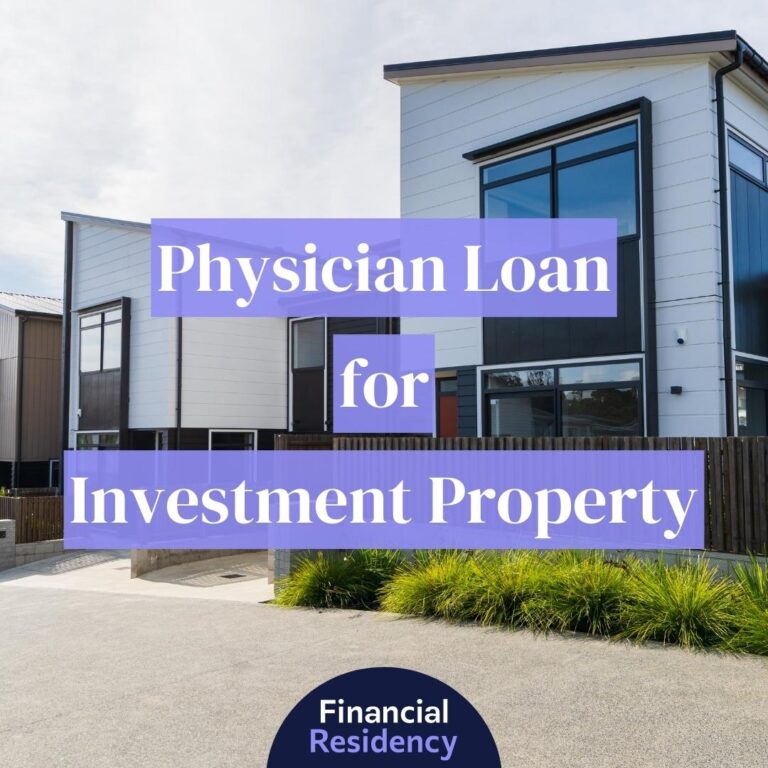One of the primary reasons people physicians are encouraged to invest in real estate is because it is a highly tax-advantaged industry. It’s no secret. In fact, most real estate investors would say the same thing.
There are several reasons why this is the case, but today we’re going to look at the tax benefits provided by doing what’s called a 1031 exchange. In theory, the concept itself is simple: Reinvest the proceeds from the sale of business or investment property into a like-kind investment in order to defer paying capital gains tax. Doing so increases an investor’s purchasing power because he can use 100% of his current property equity to invest in a replacement property. Using a 1031 exchange is a great tool for investors looking to grow their real estate portfolios.
In theory, the concept itself is simple: Reinvest the proceeds from the sale of business or investment property into a like-kind investment in order to defer paying capital gains tax. Doing so increases an investor’s purchasing power because he can use 100% of his current property equity to invest in a replacement property. Using a 1031 exchange is a great tool for investors looking to grow their real estate portfolios.
In reality, 1031 exchanges are quite complex. Section 1031 of the Internal Revenue Code (from which the term gets its name) contains many nuances that can be daunting to novice investors.
Here’s what you need to know about 1031 exchanges, including the 1031 rules that you must follow closely if you decide to leverage this tool.
Types of 1031 Exchanges
Most real estate investors are familiar with a “delayed exchange,” the most common form of 1031 exchange. Yet there are actually four different forms of 1031 exchanges, and each can be used for different purposes.
-
Simultaneous Exchange
The Simultaneous Exchange was the original 1031 exchange, and allows investors to swap properties directly, relinquishing and closing on their replacement property within the same day – hence the name “Simultaneous Exchange”. With this type of exchange, two parties literally exchange the deeds and other necessary documents to trade assets, simultaneously transferring ownership to one another. No monetary compensation is allowed.
This is the oldest type of 1031 exchange, though it is rarely used today given the operational complexities. Most investors have a difficult time finding an investment property that they want to buy, a property that happens to be owned by someone who ALSO has an interest in trading for their investment property. On the off chance an investor engages in a Simultaneous Exchange, she may use a qualified intermediary (see below) to handle the transaction, though the IRS does not require it.
-
Delayed Exchange
The Delayed Exchange is the most common type of 1031 exchange. A Delayed Exchange is one in which a third party, known as a “Qualified Intermediary” (QI), facilitates the selling of one’s property and assures that proceeds are used for the acquisition of another like-kind property. Upon the QI’s receipt of money from the sale of a property, an investor has 45 days to formally identify which replacement property (or properties) he wants to buy.
In order for a replacement property to be considered valid under the rules of the Delayed Exchange, it must meet one of the three following criteria:
- The Three Property Rule: The investor has identified up to three different properties as potential purchases within the 45-day identification period, regardless of the total fair market value of the properties.
- The 200% Rule: The investor has identified an unlimited number of replacement properties, but the total fair market value of all properties does not exceed 200% of the value of the property being relinquished through this 1031 exchange.
- The 95% Rule: The investor has identified an unlimited number of exchange properties, but he receives at least 95% of the value of all identified replacement properties before the end of the exchange period.
The “exchange period” is an important deadline investors must monitor while doing a 1031 exchange. An investor only has 180 days from the date he closes on the relinquished property to close on the replacement property, otherwise known as the exchange period. The transaction must be settled within 180 days for the Delayed Exchange to be considered successful. These 1031 rules are critically important for investors to follow.
Expect to pay between $750 and $1,250 to hire a qualified intermediary when doing a Delayed 1031 Exchange.
-
Improvement Exchange
An Improvement Exchange allows an investor to make improvements on a new replacement property using his tax-deferred equity prior to closing on the replacement property. This type of exchange is also referred to as a “construction” or “built-to-suit” exchange. It is particularly useful for investors who are interested in acquiring a property that is not of equal or greater value than the property they intend to relinquish; for investors willing to take on the ground-up construction of their new replacement property; or for investors who have identified a property of equal or greater value that is in need of significant improvements. Improvement Exchanges are complicated, but often result in an exchanger finding a better investment than he could otherwise find on the open market.
Improvement Exchanges have a few basic requirements. First, all exchange equity must be spent on improvements by the end of the 180-day exchange period (even if construction is not complete). Second, the exchanger must receive substantially the same property he identified during the 45-day identification period. And finally, the replacement property must be of equal or greater value than the relinquished property at the time of transfer to the exchanger.
-
Reverse Exchange
All of the aforementioned types of 1031 exchanges are considered “forward” exchanges. The outlier is the Reverse 1031 Exchange, which is used when an investor acquires a replacement property before conveying the relinquished property to the new buyer. These are the most complicated forms of 1031 exchanges, and most would argue the riskiest. This is because an investor is still obligated to find and close on a replacement property within the 45- and 180-day timelines. Some investors will struggle to complete the process within 180 days if another property has not yet been identified. There are other strict guidelines associated with the Reverse Exchange. For instance, an investor can never own the two properties simultaneously, which requires the investor to “park” legal title to one of those properties with a QI until the transaction is complete.
That said, a Reverse Exchange can be incredibly useful for an investor who need to act quickly. An investor may need to act on an opportunity before he has had time to even consider listing or selling the property he intends to relinquish. Alternatively, the sale of the relinquished property may fall through and an investor may still want to move forward with the property he intended to purchase using a forward 1031 exchange.
Expect to pay anywhere from $3,500 to $7,500 to hire a qualified intermediary when engaging in a 1031 Reverse Exchange.
Defining a “Like-Kind” Investment
The IRS considers “like-kind” property as any property used in a trade or business as an investment. It generally refers to real estate: single family, multifamily, commercial, retail, industrial, condos, hotels and raw land are all examples.
The term “like-kind” can be somewhat misleading. An investor who sells an apartment building is not required to purchase another apartment building. She can exchange that apartment building for raw land or a strip mall, if she so chooses—as long as that type of property is eligible for exchange.
Stocks, bonds, securities, certificates of trust, interests in partnerships and business inventory intended for sale are examples of property that cannot be sold using 1031 exchanges.
Adding “Boot” to a Deal
There are some situations in which a 1031 exchange includes the transfer of property that is not considered like-kind. For example, the sale might include a cash payment to be used toward capital improvements at the replacement property. This is called “boot”. Because the cash is not considered like-kind property, an investor may be responsible for paying taxes on the boot portion of the exchange.
An investor might also use boot to reduce the mortgage liability on the replacement property below the mortgage liability on his relinquished property. This is known as “mortgage boot.”
Reinvestment Requirement
In order for an investor to defer all of the capital gains on his relinquished property, he must purchase a property of equal or greater value. He must also reinvest ALL cash proceeds from the sale into the new property.
Contrary to popular belief, an investor does NOT have to place debt on the replacement property equal or greater to the debt that was paid off on the relinquished property (though he may). An investor can always add debt or place more cash into the purchase of a like-kind replacement property as long as proceeds from the sale have been invested in their entirety.
As a general rule, always remember: “trade up” and “no cash-out”.
A 1031 Case Study
Dr. Mary is the owner of a 12-unit multifamily apartment building in Oakland that has appreciated almost three-fold since she purchased it 20 years ago. Given this increase in value and Mary’s desire to invest in a property in a larger San Francisco property with her profits, she decides to sell the property. Before she enlists a real estate broker to market the building, Mary calls her long-time CPA to evaluate the tax considerations of selling the property.
Over the 20 years that Mary has owned the building, her net adjusted basis has decreased significantly due to the depreciation she has recognized.
Original Purchase Price: $1,500,000
Capital Improvements: $50,000
Depreciation Taken: ($1,000,000)
Net Adjusted Basis: $550,000
Mary’s CPA tells her that her capital gain and resulting tax liability will be high because of the property’s strong appreciation and low net adjusted basis. A potential sale might look like the following:
Sales Price Today: $4,250,000
Net Adjusted Basis: ($550,000)
Closing Costs: ($200,000)
Capital Gain: $3,500,000
Mary will be able to claim $1 million in depreciation recapture (generally taxed at 25%). Since Mary is in the highest tax bracket (as is the case with many physicians), the remaining $2.5 million in capital gain will be taxed at a long-term federal capital gain rate of 20% + 3.8% for the Medicare surtax. The State of California’s capital gains tax eats away another 13.3% and now Mary’s potential tax liability looks something like this:
Capital Gain: $3,500,000
Depreciation Recapture: ($1,000,000)
Net Capital Gain: $2,500,000
Tax on Depreciation Recapture (25%): ($250,000)
Federal Capital Gains Tax (20%): ($500,000)
Medicare Surtax (3.8%): ($95,000)
State of California Capital Gains Tax (13.3%): ($332,500)
Total Tax Liability: $1,177,500
But Mary doesn’t own the property outright. She still has an outstanding loan balance in the amount of $600,000. So if she were to sell for $4,250,000 she’s only walking away with $3,450,000 from the sale once she pays off her loan and pays for closing costs. After she pays taxes on those proceeds ($3,450,000 – $1,177,500) she’s really only left with about 65.8% of his sales proceeds, or $2,272,500.
Mary’s CPA also reminds her that if she were to pay the capital gains taxes and reinvest her after-tax proceeds into a new acquisition (assuming a 70% loan-to-value ratio), her purchasing power weakens. Let’s look at the comparison between using a traditional sale versus a 1031 exchange:
After-Tax Sales Proceeds: $2,272,500
Maximum Purchase Price of New Property (70% LTV): $7,580,000
1031 Exchange Tax-Deferred Sales Proceeds: $3,450,000
Maximum Purchase Price of New Property (70% LTV): $11,500,000
Purchasing Power Advantage with 1031 Exchange: $3,920,000
Mary decides it’s time to sell her 12-unit multifamily in Oakland via a 1031 exchange.
When NOT to Use a 1031 Exchange
Although we’ve touted the benefits of using a 1031 exchange, there are some circumstances in which it may not be appropriate. For example, investors generally do not want to use a 1031 exchange when they’ve experienced an actual loss on the property because they’ll want to recognize those losses for income tax purposes. Just as capital gains are deferred using the 1031 exchange, so are losses. Deferring losses that would otherwise offset large profits could outweigh the benefits of using a 1031 exchange.
1031 Exchange Pitfalls to Avoid
Any investor considering using a 1031 exchange to defer paying capital gains tax should familiarize himself with the most common pitfalls. The IRS 1031 exchange rules are complicated, and even the slightest mistake can dismantle a successful transaction.
- Trying to use a 1031 exchange to defer paying capital gains on your primary residence. The same holds true for property held as a second home (e.g. a vacation or summer home). This tool can only be used for investment properties.
What if you used to live in the primary residence but now use it as an investment property? If you have lived in the property for two out of the last five years, then you do not pay capital gains tax (up to $250,000 or $500,000 for a married couple). In this case, you cannot engage in a 1031 exchange. However, if you lived in the home for less than two of the past five years, it is no longer considered a primary residence and you may sell using a 1031 exchange. Any capital gains on the period the property was used as a rental becomes the basis for the 1031 exchange.
- Missing deadlines. This is pretty self-explanatory. The IRS has very clear 1031 rules around the 45- and 180-day timelines. Do not mistakenly assume that the IRS will grant you an extension for time. It won’t. Unless you have a really good reason. The IRS only grants extensions for three reasons: presidential declared disasters, acts of terrorism, and military actions.
- Overpaying for a replacement property. Some people, in their rush to identify a replacement property within the allowable time frame, end up overpaying for a replacement property – which negates a portion of the cost savings being realized by using the 1031 exchange in the first place. Do not advertise to sellers that you are using a 1031 exchange; this may encourage sellers to negotiate a higher price because they know you’re on a tight deadline to close the deal.
- Failing to include language in your sales contract about the 1031 exchange. The IRS does not mandate exchanges to include language in the contract for the sale of the relinquished property, but it is in an investor’s best interest to gain the cooperation of the buyer while going through the process. Include language in the contract from day 1 that asks the buyer to cooperate with the exchange.
- Hiring the wrong qualified intermediary. Not all intermediaries are equal. You want someone who is sophisticated enough to really understand the ins and outs of how to successfully complete a 1031 exchange. They should be a valued part of your team. Some QIs are more like paper pushers who send documents along to closing; whenever you have a question they’ll suggest you consult with your tax advisor. This isn’t to say that your QI should replace your tax advisor. In fact, IRS rules prohibit QIs from giving you financial advice or acting as you real estate broker. They must be a truly, independent third party. However, your QI should be able to step in and answer basic questions as they arise in order to help guide you through the process smoothly.
- Not evaluating how various types of 1031 exchanges can help you. Most people defer to using a traditional delayed exchange. The majority of investors are not even aware of the other types of 1031 exchanges. Depending on your individual circumstances, the reverse or construction exchange – or some combination of exchanges – might be a better option.
- Trying to access exchange proceeds before the transaction is complete. Exchange proceeds are required to be held in a separate escrow account and can only be accessed by the qualified intermediary until the 1031 exchange is complete. If no replacement properties are identified within the 45-day period, the exchange is considered over and the sale proceeds will be wired to your bank account. Otherwise, exchange proceeds are held until the end of the 180-day exchange period unless they are used to acquire a replacement property before then. Any attempts to hold or otherwise access the exchange proceeds yourself will deem the transaction null and void.
CONCLUSION
There are obviously several benefits to utilizing a 1031 exchange: you can defer paying capital gains tax, increase purchasing power when investing in another like-kind investment, and accumulate a larger portfolio of real estate that can eventually be passed down to your heirs. Savvy real estate investors use 1031 exchanges all the time.
But 1031 exchanges are complicated. It’s always best to have your CPA and/or real estate attorney guide you through this process. This will ensure you’re meeting all of your 1031 obligations and fulfilling all 1031 rules according to IRS guidelines.
There’s only so much you can learn from a blog about 1301 exchange. Have questions? Reach out to me at drcathycarroll@gmail.com. I’d love to help!





